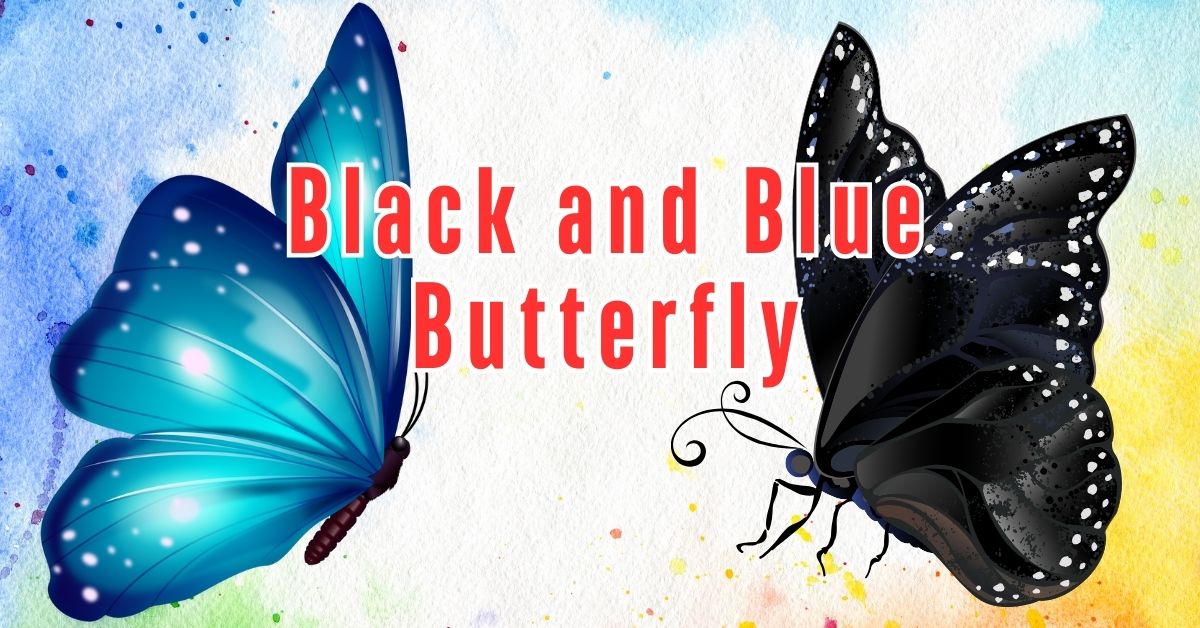Introduction: Exploring the Beauty of the Black and Blue Butterfly
The world of butterflies is filled with color and wonder, but few are as captivating as the strikingly beautiful black and blue butterfly. With their delicate wings painted in shades of deep black and vibrant blue, these butterflies have long been admired by nature lovers, artists, and cultural traditions alike. Known for their unique coloration and graceful flight, black and blue butterflies are a symbol of transformation, elegance, and the beauty of nature.
In this article, we will take an in-depth look at black and blue butterflies—exploring their various species, symbolic meanings, and natural habitats. We’ll also share some fascinating facts about these winged wonders and offer tips on how to attract them to your garden.
What Is a Black and Blue Butterfly?
Black and blue butterflies are a visually stunning group of butterflies characterized by their striking combination of black and blue coloration on their wings. These butterflies are found across many regions of the world, and their bold colors often serve as a form of camouflage, protection from predators, or a way to attract mates.
The blue hues on the wings of these black and blue butterfly often come from structural coloration, which means that the color is not due to pigments, but rather the way light reflects off microscopic structures on the butterflies’ wings. This gives them their iridescent appearance, making them shine and shimmer in the sunlight.
General Characteristics
- Wing Colors: Deep black and vibrant blue patterns, often with iridescent sheen
- Size: Varies by species, ranging from small to large wingspans
- Behavior: Active during the day, known for graceful flight and distinct territorial habits
- Diet: Feeds primarily on nectar, fruit juices, and tree sap
These butterflies are not only beautiful but also play an essential role in their ecosystems by contributing to pollination and serving as prey for other species in the food chain.
Popular Species of Black and Blue Butterfly
The world is home to a variety of stunning black and blue butterfly species, each with unique characteristics and habitats. Below are some of the most well-known species that are admired for their beauty:
1. Blue Morpho (Morpho menelaus)
The Blue Morpho Butterfly is one of the most famous and recognizable species of black and blue butterflies. Native to the rainforests of Central and South America, the Blue Morpho has vibrant blue wings with black edges, and its wingspan can reach up to 6 inches, making it one of the largest butterflies in the world.
2. Pipevine Swallowtail (Battus philenor)
The Pipevine Swallowtail is native to North America and is known for its dark, blackish-blue wings with metallic blue undertones. This butterfly is often found in gardens and open fields, where it feeds on nectar. The Pipevine Swallowtail is also a strong flier and can often be seen soaring in search of food.
3. Ulysses Butterfly (Papilio ulysses)
The Ulysses Butterfly, also known as the Blue Mountain Swallowtail, is native to Australia, particularly in the rainforests of Queensland. Its wings are a shimmering electric blue on top, with a black outline, making it one of the most striking butterflies in the region.
4. Common Bluebottle (Graphium sarpedon)
The Common Bluebottle is found in South and Southeast Asia. It is a fast-flying butterfly known for its bright blue and black wings, which flash in the sunlight as it moves through forests and gardens.
5. Black Swallowtail (Papilio polyxenes)
The Black Swallowtail butterfly is native to North America and has a combination of black and blue on its wings, along with spots of yellow. Its distinct coloring makes it a favorite among butterfly watchers.
Symbolism and Meaning of Black and Blue Butterflies
Butterflies have long been symbols of transformation, beauty, and renewal, and black and blue butterflies carry additional meanings due to their striking colors. The color black is often associated with mystery, protection, and the unknown, while blue represents tranquility, inspiration, and spirituality.
1. Transformation and Renewal
Like all butterflies, black and blue butterfly symbolize the power of transformation and personal growth. Their lifecycle—from egg to caterpillar, chrysalis, and finally butterfly—is seen as a metaphor for change and new beginnings. The black and blue coloring enhances this symbolism, representing a transition from darkness to light, from uncertainty to clarity.
2. Mystery and Protection
In some cultures, black butterflies are seen as protective spirits or omens, while the blue in their wings can symbolize hope and calm in difficult times. The combination of black and blue makes these butterflies a symbol of overcoming obstacles and finding peace through struggle.
3. Joy and Spiritual Enlightenment
The color blue is often associated with joy, harmony, and spiritual enlightenment. When a black and blue butterfly crosses your path, it can be interpreted as a sign of spiritual awakening or a reminder to seek peace and joy in everyday life.
Just like the captivating beauty of the black and blue butterfly, you can elevate your garden’s charm with 10 Stunning Purple Plants You Need to Add to Your Garden Today—discover them here!
Where to Find Black and Blue Butterflies: Habitat and Range
Black and blue butterflies are found in a variety of habitats across the globe, from dense rainforests to open meadows and gardens. These butterflies thrive in regions where nectar-rich plants are abundant, and many species are found in tropical climates.
1. Rainforests and Tropical Regions
Many species, such as the Blue Morpho and the Ulysses Butterfly, are found in tropical rainforests, where they blend into the shadows and sunlight filtering through the trees. These butterflies often rest on the forest floor and fly up toward the canopy in search of food.
2. Gardens and Open Fields
Other species, such as the Pipevine Swallowtail and Black Swallowtail, are more commonly found in gardens, meadows, and fields. They are attracted to areas where nectar plants like milkweed, verbena, and butterfly bush grow, making these butterflies more accessible to gardeners and butterfly enthusiasts.
3. Mountains and Highlands
Some black and blue butterflies, like the Ulysses Butterfly, are found in mountainous regions and highland forests, where they are often seen flying near streams and waterfalls.
Interesting Facts About Black and Blue Butterfly
Black and blue butterflies are not only beautiful but also fascinating creatures. Here are some interesting facts about them:
1. Iridescence on the Wings
The stunning blue color seen on many black and blue butterflies is not caused by pigments, but by structural coloration. The scales on their wings reflect light in such a way that it creates the illusion of blue, making these butterflies shimmer and change color depending on the angle of the light.
2. Long Migration Journeys
Some species of black and blue butterfly, such as the Pipevine Swallowtail, undertake long migration journeys to escape cold temperatures, traveling across states and even countries to find warmer climates.
3. Camouflage and Defense Mechanisms
The dark black parts of their wings help many black and blue butterflies blend into the shadows and tree trunks of their natural habitats. Some species also have eye spots on their wings that mimic the appearance of predator eyes, scaring off birds and other predators.
4. Lifespan and Life Cycle
Most black and blue butterflies, like other butterflies, have a short lifespan—typically between 2 to 4 weeks. However, their life cycle from egg to butterfly is an incredible process of metamorphosis, which can last anywhere from a few weeks to several months, depending on the species.
5. Importance in Pollination
Butterflies, including the black and blue species, play a crucial role in pollination. As they move from flower to flower, feeding on nectar, they transfer pollen and help with the reproduction of many plants.
How to Attract Black and Blue Butterflies to Your Garden
If you want to bring the beauty of black and blue butterflies to your garden, here are some tips on how to create the perfect environment:
1. Plant Nectar-Rich Flowers
Black and blue butterfly is drawn to flowers with nectar, so plant varieties such as butterfly bush, milkweed, zinnias, and verbena to provide a food source for these butterflies.
2. Provide Host Plants
Many butterfly species lay their eggs on specific plants, which provide food for the caterpillars once they hatch. For example, Pipevine Swallowtails prefer pipevine plants as a host for their larvae. Adding these plants to your garden will help support the full life cycle of the butterflies.
3. Create a Water Source
Butterflies need water, so consider placing a shallow dish or a butterfly puddling station in your garden where they can drink. You can fill it with water or moist sand to attract more butterflies.
4. Avoid Pesticides
Pesticides can harm butterflies and other pollinators, so it’s important to avoid using chemicals in your garden. Opt for natural pest control methods instead to create a safe haven for butterflies.
Conclusion: The Majestic Black and Blue Butterfly – A Symbol of Nature’s Elegance
Few creatures capture the beauty and elegance of nature like the black and blue butterfly. Whether it’s their iridescent wings flashing in the sunlight or their graceful flight patterns, these butterflies inspire awe wherever they go. Not only are they a marvel to observe, but they also play an essential role in their ecosystems by pollinating plants and contributing to biodiversity.
By understanding the characteristics, symbolism, and habitat of black and blue butterfly, you can appreciate their significance in nature. And with a few adjustments to your garden, you can attract these majestic creatures and enjoy their presence close to home.
FAQs About Black and Blue Butterflies
- What species of butterflies are black and blue?
- Common species include the Blue Morpho, Pipevine Swallowtail, Ulysses Butterfly, and Black Swallowtail.
- What is the symbolism of black and blue butterflies?
- Black and blue butterflies symbolize transformation, renewal, mystery, and spiritual enlightenment.
- Where can I find black and blue butterflies?
- These butterflies are found in various habitats, including rainforests, gardens, meadows, and mountainous regions.
- What do black and blue butterflies eat?
- They feed primarily on nectar, as well as fruit juices and tree sap.
- How can I attract black and blue butterflies to my garden?
- You can attract them by planting nectar-rich flowers, providing host plants, and creating a water source.
- Do black and blue butterflies migrate?
- Some species, such as the Pipevine Swallowtail, migrate long distances to find suitable climates for reproduction.
- Are black and blue butterflies rare?
- Some species are common, while others, like the Blue Morpho, are more elusive and typically found in specific tropical regions.
- How do black and blue butterflies get their color?
- Their color comes from structural coloration, where the microscopic structures on their wings reflect light to create vibrant blue hues.
- What is the lifespan of black and blue butterflies?
- The lifespan of most black and blue butterflies is typically between 2 to 4 weeks, though their entire life cycle from egg to butterfly can last much longer.
- Why are black and blue butterflies important to the ecosystem?
- These butterflies are important pollinators, helping plants reproduce and contributing to the biodiversity of their habitats.

Joseph Bush is a seasoned writer and researcher with over 7 years of experience covering a wide range of general topics, from lifestyle and technology to business and current events. He is dedicated to producing fact-checked, reader-friendly content that informs, engages, and empowers readers.
Throughout his career, Joseph has followed strict editorial guidelines, relied on reputable sources, and ensured every article meets the highest standards of accuracy and clarity. His expertise spans multiple fields, allowing him to explain complex topics in a way that’s easy to understand.
Passionate about continuous learning, Joseph stays updated on industry trends and best practices to deliver trustworthy, well-rounded insights. Readers can rely on his work for its credibility, depth, and real-world relevance.




